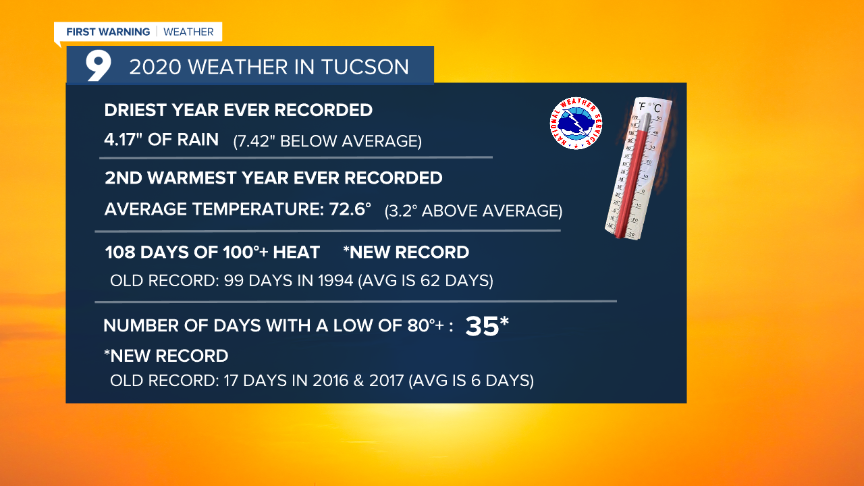TUCSON, Ariz. (KGUN) — 2020 will go down in history for so many reasons and the year will also go into the weather history books. In Tucson, according to our friends at the National Weather Service, we just experienced our driest year and our 2nd warmest year ever recorded.

We entered 2020 in great shape as far as precipitation was concerned. We came into the year close to 2.5” above average for rainfall and had virtually wiped all drought from our Arizona map. We actually received some decent rainfall the first three months of the year and, then, April arrived. Things changed quickly and it was if someone turned off the water spigot. In Tucson, April brought less than 0.10” of rain and only slightly more than a trace in May.
Usually, we could rely on monsoon to come to the rescue. Going into monsoon, we were a bit concerned that it may not be as active in 2020. Unfortunately, we had reason for concern. The monsoon came and only gave us a handful of active thunderstorm days. In Tucson, at the airport, we came within 0.03” of tying the record for the driest monsoon ever recorded!

Tucson wasn’t the only location to suffer from a poor monsoon performance. Most cities and towns reported lower than average rainfall totals from June through September. Dew points remained low and the moisture just wasn’t in the atmosphere to provide enough fuel for thunderstorms.
Those low dew points also allowed the air temperatures to soar this past summer. In Tucson, we saw temperatures climb above 100° on 108 days in 2020! That wiped out the old record of 99 days with 100°+ heat and we didn’t stop there with the records.
Hot days equal hot nights and we experienced 35 nights in which the temperature never dropped below 80°! That also set a new record. Plus, we set a new record for nights with a low temperature of 75° or higher. We had 75 nights of 75° or warmer. The old record was 62 back in 2011.
One reason our overnight temperatures are trending upward is that Tucson is growing. Our urban sprawl means more pavement and buildings. More building growth translates into more heat building up during the day and more heat radiating at night. It’s really the overnight lows that are having a big impact on our overall average temperatures.

Unfortunately, extreme heat and prolonged periods of dry weather have brought our drought conditions roaring back to Arizona. We enter 2021 looking at extreme or exceptional drought conditions across most of the state. We entered the year with about a 7.5” deficit in the rain gauge and haven’t had any rain in the first week of the year.

As we look forward to what 2021 will bring, the weather models from the Climate Prediction Center don’t look too promising. For the next 3 months, precipitation will continue running below average and temperatures will remain above average. A weak La Niña will be in play through the spring. La Niña usually keeps the Southwest drier than average which often results in temperatures running a little above average.

For now, we have to hope that an occasional storm system will find its way across southern Arizona or get a few sub-tropical systems to come over from Baja. If nothing else, something to just get dew points a little higher even if we don’t get rain or snow.

Beyond the next couple of months, it’s tough to tell what the weather will bring. Monsoon should be more active in 2021. If so, more moisture would be available in the ground to help create and support more rain through the end of the year. Let’s keep hoping this scenario comes true!



